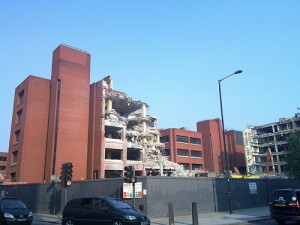
The Japanese Way of Demolishing Structures
Chicago, IL – Traditional demolition techniques require the use of explosives or the famous iron ball. With explosives, the idea is to create an implosion, where the building will collapse inward on itself, preventing damage to other nearby structures. Even so, the implosion can cause unexpected damage to those other structures, as well as hazards for any people passing by. For this reason, implosions are normally avoided in high congestion areas, where there is a risk of causing personal injury or damage to other structures.
Besides the risks involved, normal demolition techniques create an environmental hazard. The implosion itself and any subsequent demolition create huge quantities of dust, which affect everyone nearby. The demolished material from the building is a disposal problem, creating huge amounts of trash for landfills if it can’t be recycled.

Civil engineers in Japan have sought new methods to avoid these problems. With the high crowding of Japanese cities, the ability to implode a building, without damaging adjacent structures is unlikely. Besides that, Japanese environmental laws require that the concrete and wood be recycled, not just the steel, aluminum and copper.
Recent demolition projects in Japan have showcased these new methods. For the 40-story Akasaka Prince Hotel, a movable cap was placed on the building. This cap consisted of a scaffold that was covered with material to make it look like part of the building. The top two floors were then dismantled in place, “deconstructing” the building. As work progressed, the scaffolding cap was lowered by hydraulic cylinders, allowing it to cover the next two floors for their dismantling.
Dismantling the building in this manner lowers noise pollution by 20 percent and dust by 90 percent. The average person walking by doesn’t even see the work going on in the building, merely seeing that the building grows gradually shorter over time.
In another project, the Resona Maruha building was dismantled from the ground up. The building’s 40 columns were supported by huge hydraulic jacks, as the columns were cut. The floor was then dismantled and the building lowered one floor. Work continued in this manner until the entire building was demolished.
Both of these techniques make it much easier to scavenge and recycle the materials from the demolished buildings, which Japanese law requires be sorted at the demolition site for recycling. With the ground-up style used for the Resona Muruha building, recycling is made very easy and efficient by the fact that the demolition work is being done at ground level.
While skyscrapers are designed for long life spans, Japan’s lack of space shortens their effective life. Both of these structures will be replaced by larger buildings, providing more usable floor space in the same footprint.
These same techniques may be useful in other parts of the world, even here in the United States. New York City is replete with large buildings that are reaching the end of their useful lifespan. The city has been very frugal in issuing permits for imploding buildings, forcing contractors to look at other means. These new techniques that have been developed in Japan may very well find a new home in New York, as the city and its commercial inhabitants look for ways to modernize their city.



